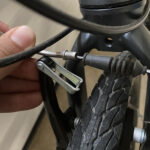The cycling world is abuzz with whispers and worries, and much of it seems to stem from concerns about head tube angles. But for some of us, the real anxiety lies elsewhere, potentially impacting the future of beloved models like the Specialized Fatboy. It seems the loudest voices in the bike community often come from those shredding gravity trails, setting the tone and sometimes overshadowing other disciplines. This can lead to a kind of “bully pulpit” effect, where certain trends dominate discussions, sometimes at the expense of niche but passionate segments, like the fat bike community. Remember the intense anti-ebike sentiment that once flooded forums, driving away regular emountain bike owners? We wouldn’t want to see a similar scenario impact the fat bike world.
This brings us to a concerning question for fat bike owners: is the Specialized Fatboy, a long-standing and respected model, potentially facing discontinuation? This thought is particularly unsettling for those of us who appreciate the unique capabilities and sheer fun of fat bikes. One can’t help but wonder if Specialized might discontinue popular tires like the Ground Control 4.6s, too. We’re talking about a massive, billion-dollar bicycle corporation, one that undoubtedly analyzes market trends and sales figures meticulously to make strategic decisions. The question is, what are those tea leaves telling them about the fat bike market, specifically the “Fat Bike Fat Boy”?
Is the potential issue a lack of lineup expansion, perhaps the absence of a dual-suspension fat bike model to complement the enduring hardtail Fatboy? Or are Specialized’s market researchers indicating a broader, more ominous trend – an overall decline in fat bike sales across the board? Perhaps the substantial profits generated by their e-bike division are so significant that a lower-volume niche like fat bikes might be deemed expendable. For those of us deeply invested in the fat bike experience, the hope is that the Fatboy isn’t becoming the canary in the coal mine, signaling a larger shift away from fat bikes by major manufacturers. Because for many who frequent fat bike forums and communities, the “fat bike fat boy” – and fat bikes in general – represent the most enjoyable innovation in cycling since childhood, since that liberating moment when training wheels came off.
Speaking personally, I own a 2014 Fatboy model, purchased in late 2014. My intention was to create a versatile, touring-capable bicycle. Living in New Jersey, my riding environment includes the sugar sand roads of the Pine Barrens, local asphalt roads, and the extensive canal towpath trails along the Delaware River. To achieve my touring vision, I equipped my “fat bike fat boy” with Surly Nice racks, a Thudbuster seat post for enhanced comfort, Cane Creek bar ends for varied hand positions on long rides, a Brooks Cambium saddle for all-day comfort, and a comprehensive lighting system. This system features a Schmidt dyno hub powering a B&M IQ front light and a Schmidt rear tail light for reliable visibility. To improve braking performance, I installed Shimano Ice Tec rotors, hoping to alleviate the infamous screeching of the stock Tektro hydraulic brakes that many Fatboy owners are familiar with (though, admittedly, it only helped marginally). Finally, I added Ortlieb pannier bags in hazel brown and black, chosen for both their practicality and aesthetic appeal.
For the type of riding I do – predominantly flat, water-level routes with gentle hills – the Fatboy performs flawlessly. The accompanying photographs were taken during a 52-mile ride, a 26-mile out-and-back route entirely on roadside asphalt shoulders. Unfortunately, South Jersey lacks mountains and challenging downhill singletrack to truly test the bike’s handling in extreme conditions. My bike setup and riding style are very much a product of my local environment.
As mentioned earlier, the potential discontinuation of a long-standing bike model is never good news, especially for dedicated riders. It’s a loss for the entire fat bike community. Think of iconic American cars like the Mustang, Camaro, and Challenger. Imagine one of those being discontinued – the automotive landscape just wouldn’t feel the same.
The Fatboy is undeniably a well-engineered and well-made bike, produced by a company that is expert at optimizing profit margins while still providing components that are “good enough” to get the job done. If the Fatboy’s time is coming to an end, it will be a true RIP for a fantastic machine.

